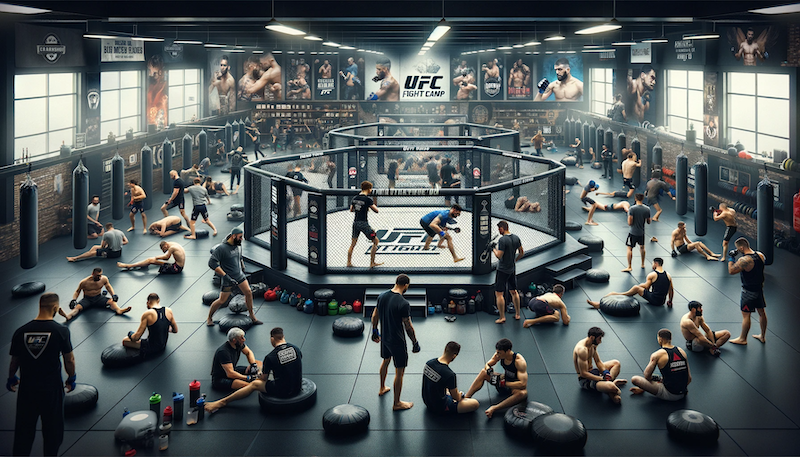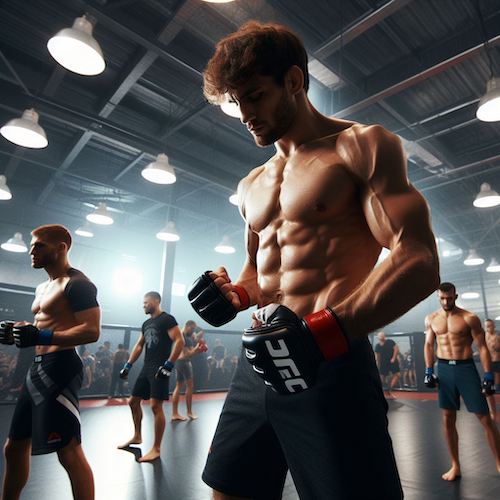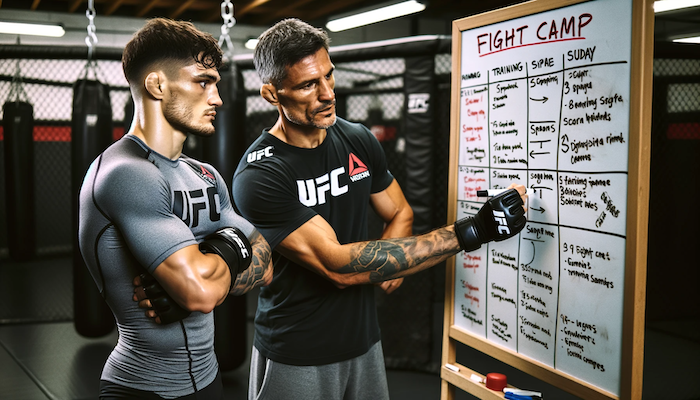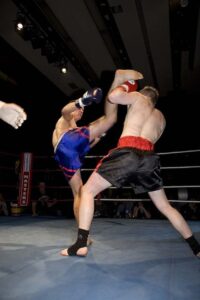
In the high-octane world of the UFC, the preparation leading up to a fight is as crucial as the bout itself.
This article delves into the intricacies of UFC fight camps, including their length, definition, makeup, diet, costs, and schedule.
Contents
How Long Is a UFC Fight Camp?
The average UFC fight camp is 6 to 12 weeks (1.5 to 3 months) long and lasts up to weigh-ins. It’s usually this length because it’s perfect for optimizing fight performance and it’s also when most fights are signed.
6 to 12 weeks is the average length of a UFC fight camp because it allows fighters adequate time to practice their game plan and sharpen their skills, cardio, and mindset.
6 to 12 weeks also allows UFC fighters to cut weight slowly so they have good energy levels and strength despite potentially cutting large amounts of weight.
However, depending on a fighter’s schedule, training style, and specific fight preparation needs, a UFC fight camp can be as short as 4 weeks and as long as 4 months.
UFC fight camps are often longer than 12 weeks if an opponent pulls out of the fight and a short-notice replacement isn’t found.
If possible, this fighter will sign to fight on an upcoming card within the next 4 weeks, and other times they’ll rebook for a fight 3 months away.
The UFC is generally good at rebooking a fighter in one of the upcoming events, but in rare cases, a fighter can end up having a fight camp of 6 months if they choose to continue training throughout.
For major fights and championships, UFC fight camps can extend up to 16 weeks (4 months).
On the other hand, some fighters have very short fight camps of less than 4 weeks if they’re willing to accept a short-notice fight.
Here are some examples of UFC fight camp lengths:
- Chad Mendes: 2 weeks notice before his UFC 189 fight against Conor McGregor
- Stephen ‘Wonderboy’ Thompson: Mostly has a 6-week fight camp.
- Kelvin Gastelum: 20 weeks (5 months) – he had 3 months of camp for his fight against Robert Whittaker which was canceled. This was followed by a 2-month camp for his fight against Israel Adesanya.
The main things affecting the length of a UFC fight camp are:
- Amount of weight needing to be cut.
- Amount of weight needing to be gained.
- How far out the UFC bout agreement is signed.
- The amount of time needed to prepare for a specific style of opponent.
- Fight cancelations.
- How much money a fighter has to invest.
- If a fight is scheduled in a location with a significantly different altitude or climate than the fighter is accustomed to, additional time might be needed for acclimatization.
What Is a UFC Fight Camp?

A UFC fight camp, or UFC training camp, is a period of intense, dedicated training and preparation undertaken by a fighter in the lead-up to a scheduled bout.
More than just regular training, a fight camp is tailored to prepare the fighter for a specific opponent, emphasizing peak physical conditioning, strategic planning, and mental readiness on the night of the fight.
The term ‘camp’ derives from ‘encampment,’ reflecting the idea of a group working together towards a common goal.
It’s a holistic approach that encompasses:
- Physical Training: Focused on enhancing fighting skills and conditioning.
- Strategic Planning: Developing a game plan tailored to the opponent’s strengths and weaknesses.
- Mental Conditioning: Building mental resilience and focus.
Fight camps can vary in their setting. Some fighters choose large MMA gyms bustling with other professional fighters, which offer a wide range of sparring partners and expert coaching.
Others may opt for smaller, more private settings where they can focus on their strategy, training, and coaching away from the public eye.
The main aim of a UFC fight camp is to train harder and prepare more extensively than ever before so that the upcoming fight seems easy in comparison.
What Goes on in a UFC Fight Camp?
A UFC fight camp is a rigorous schedule that involves various training and preparation activities.
Key components of a UFC fight camp include:
- Weight Cutting: Maintaining muscle and slowly dropping body fat is optimal. Most fighters look to lose roughly 1 to 2 lbs per week during fight camp.
- Cardiovascular Endurance: The goal of most UFC fighters is to outlast their opponent when fighting. Therefore, UFC fighters are performing tonnes of cardiovascular endurance exercises during fight camp.
- Technique Training: Striking, wrestling, and ground grappling skills are refined.
- Physical Conditioning: This includes strength, agility, and endurance training to ensure the fighter is in peak physical condition.
- Sparring: Sparring brings a fighter’s training together and gets them in the flow of fighting. It allows them to see where they need to improve and focus. Fighters spar opponents similar in style to their upcoming opponent.
- Medical Check-ups: Regular health assessments are conducted to monitor the fighter’s fitness and recovery from any injuries.
- Media Training: Fighters often undergo media training to handle press conferences and interviews effectively.
- Recovery: Methods like stretching, ice baths, and other restorative practices are crucial to ensure the fighter reaches fight night in optimal condition.
- Strategy: Fighters and their coaching team watch countless hours of tapes on their opponent and meticulously work on strategies tailored to counter their strengths and exploit their weaknesses.
- Diet and Nutrition: A specialized diet plan is essential to maintain energy levels while meeting weight class requirements.
- Mental Preparation: Mental conditioning is crucial for building confidence, focus, and resilience.
Why Most UFC Fighters Have Their Fight Camps at MMA Gyms

Most UFC/MMA fighters prefer to have their fight camps at large MMA gyms for the 5 following reasons.
- Many Professional Fighters: Training and sparring together, pushing each other, sharing knowledge and strategies, and lifting morale.
- Diverse Training Partners: Along with having many professional fighters, large gyms offer a diversity of sparring partners. Fighters can train with partners of different sizes, skill levels, and fighting styles, which is vital for preparing for various types of opponents.
- Everyday Access to Top Coaches: Each has expertise in their martial arts or domain.
- High-Quality Facilities and Equipment: Large MMA gyms usually offer state-of-the-art facilities and a wide array of training equipment. This includes specialized gear for strength and conditioning, various types of punching bags, mats for grappling, and often a full-sized cage or ring.
- Mental and Emotional Support: The community aspect of a large gym can offer significant mental and emotional support. Having peers who understand the rigors of fight preparation can be invaluable in dealing with the stresses of training and competition.
On the other hand, some UFC fighters have their fight camps away from large gyms for the 5 following reasons:
- Tension: Large MMA gyms can cause tension and stress when fighters or the same MMA promotion and weight class are training and sparring alongside each other. Especially when they may have to fight each other in the near future. Often this results in one of the fighters leaving.
- Avoiding Distractions: Large gyms can sometimes be bustling with activity, media, and other distractions. A smaller gym can offer a more controlled and focused environment, which is beneficial for fighters who prefer a quieter setting for concentration.
- Personalized Attention: At smaller gyms, fighters often receive more personalized coaching and attention. This can be crucial for working on specific techniques or strategies tailored to their fighting style or the specific opponent they will be facing.
- Privacy and Secrecy: Preparing for a fight often involves developing specific strategies and techniques that a fighter may not want to reveal to a broader audience. Training at a smaller gym can help maintain the confidentiality of their game plan.
- Cost and Accessibility: Training at a large, prestigious gym can be expensive. Some fighters may opt for smaller gyms due to financial reasons or because a smaller gym is more accessible geographically.
UFC Fight Camp Diet

A UFC fight camp diet is tailored to optimize a fighter’s performance and weight management.
Calories
Most fighters are in a calorie deficit in order to lose body fat, but some opt for maintenance calories while burning extra calories through their training.
They need enough calories to train intensely and optimally, while slowly losing body fat for the upcoming weigh-ins. How much body fat a fighter has to lose determines the calorie deficit they’ll be in.
6-12 weeks of strict preparation allow for a fighter to lose roughly 6-12 lbs of body fat in the lead-up to the fight, around a pound of fat per week.
As a pound of fat equates to around 3500 calories, they aim to be in a caloric deficit of 500 calories a day (500 x 7 = 3500).
If they lose weight faster than this during training camp, they’re likely to lose muscle mass and feel very weak before they have to water flush. Their training is also likely to be less optimal.
Macronutrients
It’s more efficient for a UFC fighter to consume fewer carbohydrates during this period, as fewer carbohydrates result in less glycogen and blood sugar available.
Therefore, the body turns to fat for energy. It also prepares the body for carbohydrate restriction during the upcoming water flushing during fight week.
Carb restriction also means a fighter can keep their protein higher while in a caloric deficit, in order to maintain lean muscle mass and keep themselves feeling full throughout the day.
It also allows for a higher percentage of healthy fats in their diet, helping the body absorb vital nutrients, keep blood pressure under control, and protect organs.
This is helpful and important when it comes time to water flush as a fighter’s organs can malfunction because of dehydration.
Despite fight camp being the most efficient way for a fighter to slowly lose any excess fat necessary, if they need to fighters may aggressively attempt to cut more body fat during the water flush week.
This is because it compliments their water flush as they’ll be taking in less food, carbs, and salt. In extreme weight-cutting cases, fighters may eat as little as 600 calories and fast for up to 20 hours per day.
Key Aspects
- High Protein Intake: Essential for muscle repair and growth. Meats, fish, eggs, nuts, protein shakes, pulses, and yogurt.
- Controlled Carbohydrates: Carbs are managed to fuel training sessions while aiding in weight control. Potatoes (white or sweet), rice (white or brown), whole wheat (pasta, wraps, bread), quinoa, oats, and chickpeas
- Healthy Fats: Essential in providing energy as well as regulating hormones and the uptaking of nutrients and vitamins. Olive oil, nuts (almonds, walnuts), avocado, eggs, seeds (chia, flax), fatty fish (salmon), and tofu.
- Hydration: Adequate water intake is crucial for physical performance and recovery. Fighters consume at least 4 liters and as much as they need.
- Nutrient-Rich Foods: Emphasis on fruits and vegetables for vitamins and minerals for overall health, energy, and fiber (fullness).
- Calorie Management: Caloric intake is closely monitored to ensure the fighter is heading toward their weight class while having enough energy for training.
How Much Does a UFC Fight Camp Cost?
A UFC fight camp for 6 to 12 weeks can cost between $2,000 and $8,000.
Fight camp can cost a fighter 5-10% of their total fight purse for each fight but it can depend on the negotiations between a fighter and their team or gym.
For fighters earning a $20,000 fight purse, that equates to a maximum of $2,000 for a team of 3 or 4 people for a 2 to 3-month period – which isn’t enough. In this case, they’re likely paid per session or per month.
Former UFC fighter John Cholish has said fight camp costs between $8,000-$12,000, which is more realistic for 2 or 3 months of work for coaches, nutritionists, strength and conditioning trainers, or any other specialists they hire.
Higher-paid fighters are also likely to pay a flat fee rather than a percentage because 10% of a $1 million fight purse is $100,000, which is way too much for a couple of months’ work.
Higher-paid UFC fighters are also more likely to exceed 8 or $12,000 as they pay for private coaching and/or bring in outside specialists.
It’s a lot of money for fighters to pay out for, but it’s an essential cost because they have to keep their skill level high in a constantly evolving sport. Their team also helps a fighter with mental health in an otherwise lonely sport.
A great team is essential in taking a fighter from earning a $20,000 purse to earning a $200,000 purse.
Here’s a closer look at what a fighter pays for during fight camp:
- Training Fees: The primary cost for any fighter is the fee for training at a gym. Prestigious gyms with renowned trainers command higher fees. This cost also includes access to facilities and equipment.
- Coaching: Specialized coaching, including striking, grappling, strength, and conditioning coaches, can significantly add to the cost. These experts charge for their time, expertise, and sometimes, for developing specific game plans for the fighter.
- Nutrition and Diet: Proper nutrition is crucial for a fighter’s performance and weight management. Hiring a nutritionist or dietician, along with the cost of specific diets and supplements, can be a considerable expense.
- Medical and Therapy Costs: Regular medical check-ups, along with physical therapy sessions for injury prevention and recovery, are essential but can be costly. This also includes any rehabilitation for pre-existing injuries.
- Sparring Partners: Some fighters hire sparring partners, especially if they need to train against a specific fighting style. These partners are typically compensated for their time and risk.
- Accommodation and Travel: For fighters who travel to a different location for their camp, accommodation and travel expenses can add up quickly, especially for extended camps.
- Equipment and Gear: Personal training gear, including gloves, pads, protective equipment, and specific workout clothing, is another necessary expense.
- Miscellaneous Costs: Other costs can include fees for managing weight cuts, mental coaching, and any additional training resources or seminars.
Overall, $2,000 to $8,000 is likely more than enough to cover the average UFC fighter’s fight camp.
However, some fighters may be able to spend less, and others, such as champions, a whole lot more.
UFC Fight Camp Schedule

Every fighter has different needs and wants during a UFC fight camp, so there will never be an exact schedule.
However, here’s how an 8-week UFC fight camp schedule may look for the average UFC fighter.
Weeks 1-2: Foundation Building
- Objective: Establish a fitness base, fight camp diet, and assess technical skills. Coaches also research the opponent to find weaknesses.
- Activities: Cardiovascular exercise, strength and conditioning, light technical drills (striking, wrestling, and Bjj), and initial strategy discussions. Emphasis on identifying areas of focus for the upcoming weeks.
Weeks 3-4: Increase Training Intensity and Integrate Strategy
- Objective: Intensify technical training and start integrating fight-specific tactics.
- Routine: Two daily sessions – focusing on martial arts skills in the morning and strength, conditioning, and medium-intensity sparring in the evening.
Weeks 5-6: Strategy Implementation and Sparring
- Objective: Sharpen fight strategies and engage in more rigorous sparring.
- Focus: Customized training to emulate the opponent’s style, with sparring partners chosen to mimic the opponent’s tactics.
- Recovery: Prioritize rest and recovery techniques, balancing the increased intensity.
Week 7: Peak Training
- Objective: Push physical and technical abilities to their peak.
- Activities: Most intense training week with the hardest sparring sessions, fine-tuning techniques, and strategies.
Week 8: Tapering and Mental Preparation
- Objective: Reduce physical strain and focus on weight management and mental readiness.
- Activities: Light workouts, strategy refinement, and weight cut management.
Fight Week
Very light physical activity, with a focus on mental strategies, rest, weight cutting (sweating to lose water weight), relaxation, and media obligations.




